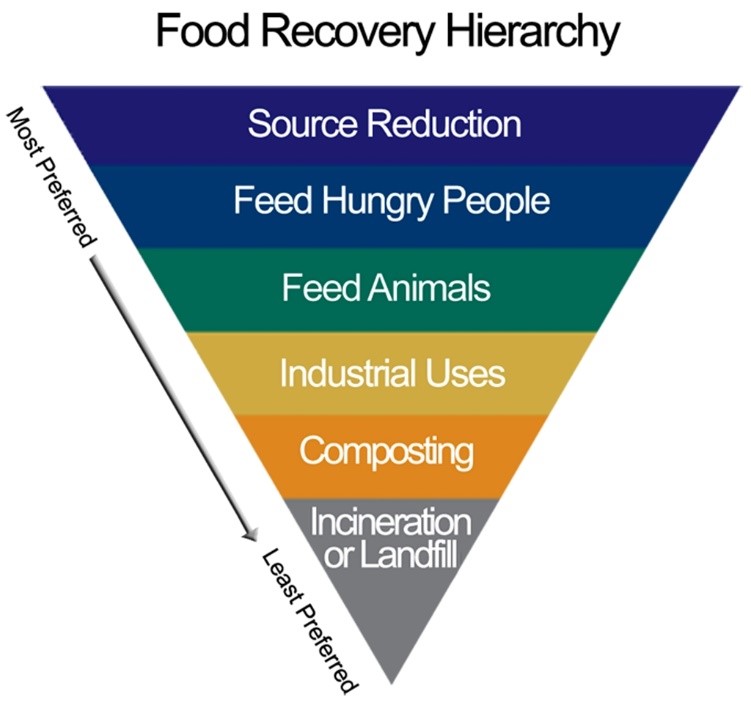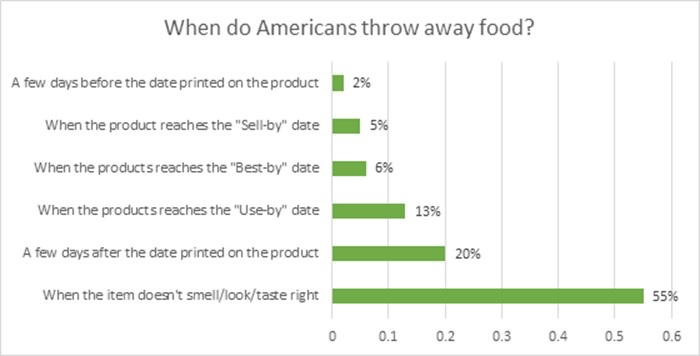Food Insecurity: An Introduction
1.4 What Can We Do?
Food Loss and Food Waste
Food loss is the edible amount of food, postharvest, that is available for human consumption but is not consumed for any reason.23 The FAO defines it as “any food that is discarded, incinerated, or otherwise disposed of along the food supply chain from harvest or slaughter.”24 In addition to natural shrinkage through cooking or moisture loss, these losses include spoilage, contamination by insects, rodents, birds, molds, or bacteria, or issues with transport or storage. Food loss occurs at every stage of production.
Food waste is the decrease in quality or quantity of food resulting from actions of retailers, food service providers, and consumers.24 At the retail level, foods can be damaged by equipment malfunction such as problems with refrigeration, or foods can be stored improperly. Blemished produce is not considered optimal and is thrown away during sorting. Date labeling, as discussed in previous chapters, causes many foods to be discarded by both retailers and consumers although it is still safe to consume. Restaurants and households discard edible foods that are unused or leftover for various reasons.23 Food that is produced but not eaten also wastes precious resources such as land, water, energy, soil, and seeds. It also needlessly increases greenhouse gas emissions since food waste breakdown creates methane.24
Although the actual amount is difficult to measure, estimates indicate that about one third of food is wasted worldwide.24 The USDA estimates this is about 133 billion pounds of food or 30-40% of the US food supply. This translates to about 219 pounds per person costing $162 billion.23 The Environmental Protection Agency (EPA) estimates that food waste comprised approximately 23% of our landfills and incineration facilities in 2018. That waste alone in landfills generates 20% of the US methane emissions.25
Many organizations are trying to tackle this global problem. The best way to reduce food loss and waste is to not create it in the first place. Improved product development, storage, shopping and ordering, marketing, labeling, and cooking methods can all contribute to this reduction. The FAO works with governments and other international groups promoting awareness and assisting with policy development. They also coordinate with food supply chains from farmers to processors and traders to educate and assist in loss and waste reduction.24 The USDA has partnered with the EPA to try to tackle this problem with the goal of reducing food loss and waste by 50% by the year 2030.25 Together they developed a Food Recovery Hierarchy. The most preferred method of reducing food loss and waste is source reduction followed by using excess foods to feed hungry people, feed animals, use in industry, or composting. The last resort should be sending excess food to a landfill or incinerator.26

Source Reduction
Source reduction is the best way to reduce food loss and waste. It can prevent pollution related to food production, reduce methane emissions from landfills, and it can save money and labor costs by encouraging buying only what is needed, avoiding disposal costs, and providing more efficient handling, preparation and storage of food that will actually be used. To do this, businesses or individuals can conduct a food waste audit by recording what is being thrown out. Before discarding food waste in the trash, weigh it and record the type, amount, and reason it’s being discarded. Get the staff or family involved in developing ideas for reducing waste.27
Tips for waste reduction at the source for restaurants:27
- Reduce batch sizes
- Use cook to order instead of bulk cooking, especially toward the end of the day
- Use as much of the food as possible (don’t peel the vegetables) and use leftovers
- Freeze surplus produce near the end of peak freshness, then use later
- Marinate meats to extend shelf life a few days
- Use see-through containers to see what is available and fresh
- Eliminate garnishes that typically don’t get eaten
University of Texas at Austin
After a food waste audit in dining halls for five days in Spring of 2008 the University of Texas at Austin found that students left an average of 5.7 oz of edible food on their plates. Staff began to work to engage and encourage students with signs to visualize their daily waste with symbolic trash cans. They began to allow students to sample menu items before choosing, and kitchen staff were trained on portion control. They continued to track pre and post consumer waste.27
A second audit was completed in Fall 2008, this time showing only 3.9 oz of edible food waste—success! But that wasn’t enough. They were able to reduce food waste by 48% by not providing trays by Fall 2009. The university continues to show a steady decline in food scraps. Between 2015 and 2016 there was an additional 18% decline, and all plate waste that remains is now being composted.28
Donate for Humans or Animals
If excess food is produced, donate it to a food bank or food rescue organization to help feed those in the community who are food insecure instead of sending it to a landfill. Nonperishable and unspoiled perishable foods can be donated, and some food rescue groups will pick up the donations free of charge. Check with the local food bank or online for organizations that can help you donate. Corporations can also receive tax benefits for their donations!29
Excess food can also be donated to farmers to feed their animals. Check with the local solid waste, agricultural extension, or public health agency for information. It is often cheaper to do this than to haul food waste to a landfill. Rutgers University and MGM Resorts International both donate food scraps from dining areas to local farms, saving significant cost on waste removal and reducing food waste.30
Industrial Uses
Another use for food waste is as a biofuel or bioproduct. Fats, oils, and grease can be collected and used as raw materials for animal food, cosmetics, soap, and other products. They can also be converted into biodiesel fuel or biogas. Several universities send their food waste to local wastewater treatment plants where it is turned into fuel that generates power for the campuses.31
Composting
Composting is another option for food waste. When organic wastes such as food, yard trimmings, and manure are combined with bulking agents such as wood chips, the wastes break down. The compost can be used as a natural fertilizer instead of using chemicals. It also can improve habitat revitalization and reforestation by improving the health of marginal or depleted soils.32 Some communities take up organic waste separately from other household wastes, usually by providing a separate waste container. The City of San Antonio Solid Waste Management Department in Texas provides a green cart for items such as food waste, food soiled paper (pizza boxes, coffee filters, etc.), yard trimmings, shredded paper and small wooden items (e.g., popsicle sticks) that is picked up from each home weekly. These items are composted, and the compost is made available for free to community members and organizations for use in gardens and landscaping. In 2020, this program diverted 70,000 tons of material from the landfill.33
Efforts at the Consumer Level
All of us can play a role in reducing food waste. The FDA34 and EPA35 have developed some tips to help consumers reduce waste, save money, and protect the environment.
At the Grocery Store or When Eating Out34
- Pre-plan and write a shopping list before going to the grocery store. Check your refrigerator and pantry to see what items you already have, and plan your eating to use those items first.
- Stick to your list and buy only what you need at the store. Shopping online and getting groceries curbside can reduce your “impulse” purchases.
- Be careful when buying items with limited shelf life in bulk. You don’t save money if you have to throw it out before it can be used.
- If available, purchase “ugly” fruits or vegetables—those with slight physical imperfections. These are safe to eat and nutritious, and can sometimes be found at a discount.
- When eating out, ask for a smaller portion to prevent waste and minimize overeating. If they do not have a smaller portion, ask for a “to go” container and take leftovers home or split a plate with a friend. You can also bring your own container to most places, minimizing the waste of the container.
In the Kitchen: Storage34,35
- Make sure the temperature setting of your refrigerator is 40° or below, and the freezer is 0° to keep foods safe.
- FDA has a FoodKeeper App containing information about how to safely store foods in the refrigerator and freezer to maintain freshness and quality.
- Refrigerate peeled or cut veggies for freshness and to keep them from spoiling.
- Freeze, preserve, or can surplus fruits and vegetables—especially abundant seasonal produce.
- Many fruits give off natural gases as they ripen, making other nearby produce spoil faster. Store bananas, apples, and tomatoes by themselves, and store fruits and vegetables in different bins.
- Create a designated space in the fridge to put items that will spoil within a few days. Make it visible, and tell your family so that these items can be eaten.
In the Kitchen: Prep34,35
- Prepare perishable foods soon after shopping. Wash, dry, chop, dice, slice, and place your fresh food items in clear storage containers for snacks and easy cooking.
- Freeze food such as bread, sliced fruit, or meat that you know you won’t be able to eat in time.
- Cut your time in the kitchen by preparing and freezing meals ahead of time.
- Prepare and cook perishable items (chicken breasts, taco meat, etc.), then freeze them in meal-sized units for use throughout the month.
All of us have a role to play in reducing food loss and waste. Check the fridge/freezer and pantry often so that you can use what you have instead of buying something new. If you have excess food, consider donating packaged food to your local food bank or pantry. Finally, learn about date labeling. As we discussed in both Chapters 2 and 3, the only date label that pertains to food safety is the “Use By” date on infant formula. All other dates are about food quality, not safety. Only 55% of consumers say they throw away food only if it doesn’t smell, look, or taste right.36 (See Figure 1.4.2) The FDA supports efforts by the food industry to standardize phrasing, but currently date labels are applied by manufacturers at their own discretion. Confusion about date labeling contributes to about 20% of consumer food waste.34

